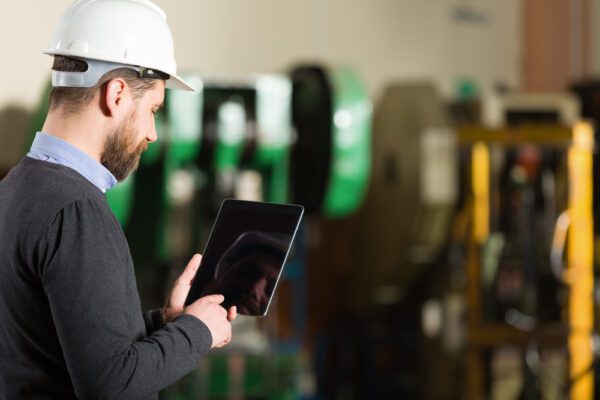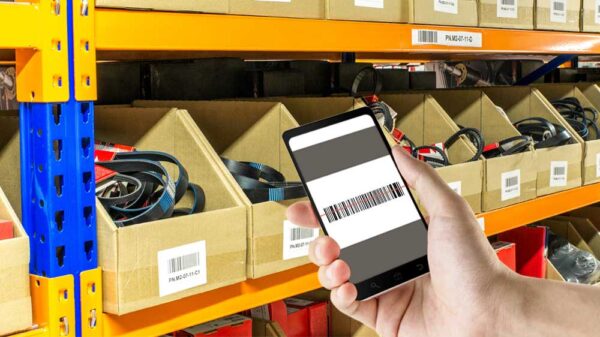
Mobile computerized maintenance management system (CMMS) software is becoming a critical tool for today’s maintenance teams, enabling technicians to manage their daily tasks from virtually anywhere. While it might be tempting to rely on personal smartphones, tablets, or laptops to access maintenance data, many organizations quickly discover that consumer-grade devices can’t survive harsh industrial environments.
To address this, many technology manufacturers offer rugged mobile devices designed specifically for maintenance and industrial use. These devices withstand drops, moisture, extreme temperatures, and other conditions that can damage standard hardware. This article explores what to look for when selecting mobile devices so that your organization can choose hardware that will support your mobile CMMS and provide long-term benefits to your maintenance team.
Why Durability Matters: Consumer-Grade vs. Rugged Mobile Devices
Not all mobile devices are built for industrial environments. While consumer-grade smartphones, tablets, and laptops are convenient and familiar, they aren’t designed to withstand the wear and tear of maintenance work. Drops, dust, moisture, extreme temperatures, and exposure to chemicals can easily damage standard devices, leading to lost productivity and downtime.
Rugged devices, on the other hand, are specifically built for demanding environments. They feature reinforced casings, drop protection, water and dust resistance, and other protective measures to ensure reliable performance. Investing in rugged hardware helps maintenance teams maintain consistent access to mobile CMMS software, even in harsh conditions.
By understanding the differences between consumer and rugged devices, organizations can make informed decisions that protect both their technology investment and the efficiency of their maintenance operations.
Rugged vs. “Ruggedized” Mobile Devices
As a cost-saving measure, some organizations opt to install tough outer cases on standard devices instead of purchasing rugged hardware. While this solution may be acceptable in some environments, beware that these “ruggedized” devices still have sensitive internal components and are not the same as rugged devices. Rugged devices are specially designed, inside and out, to withstand harsh conditions, though they come at a higher cost.
Hardware Device Standards and Compliance
When evaluating rugged mobile devices, it’s important to understand the standards and certifications that ensure durability and reliability. Compliance with industry benchmarks indicates that a device has been tested to withstand harsh environmental conditions, such as water, vibrations, and extreme temperatures. Familiarity with these standards can help you make informed decisions about the hardware you give to your team. Below are some durability standards to be aware of.
Ingress Protection (IP) Rating
Ingress Protection (IP) rating is an international standard, developed by the International Electrotechnical Commission (IEC), to grade the degree of protection against intrusion of dust or liquids. IP ratings are expressed as two digits:
- The first numeral indicates protection against solid objects on a scale from 0 to 6, with 0 being no protection and 6 being no ingress of dust.
- The second numeral is the level of protection against liquids on a scale of 0 to 9, with 0 being no protection and 9 being protected against high pressure and temperature water jets.
For example, an IP rating of IP65 means the device is dust tight and protected against water jets. Refer to the IEC’s Ingress Protection Ratings Guide for more information.
MIL-STD-810 Compliance
MIL-STD-810 is a standard used by the United States Department of Defense (DoD) to ensure equipment functions reliably while under real-world stress caused by vibration, shock, extreme temperature ranges, and other conditions. While this standard was developed specifically for military purposes, it is often used for testing rugged technology products as well.
To be MIL-STD-810 compliant, manufacturers must meet several guidelines, including sending devices to external testing laboratories. Because external testing can be expensive, some manufacturers choose to do in-house testing according to the official standards documentation.
Be warned that many manufacturers claim their products are MIL-STD-810 compliant even though they are not! Sometimes, products have not even been tested. Therefore, be sure to investigate any claims of compliance and ask about what standards the device passed, what test methods and parameters were used, and what the test results concluded.
Common Environmental Tests
To verify an IP rating, demonstrate compliance with MIL-STD-810, or meet other durability standards, manufacturers perform a variety of environmental tests on rugged devices. These tests simulate real-world conditions common in industrial environments. Types of durability tests include:
- Drop and shock testing: Requires devices to withstand multiple drops from specified heights.
- Temperature testing: Tests a device under normal operating conditions in extreme temperatures.
- Liquid-resistance testing: Measures a device’s water resistance.
- Vibration testing: Shakes the device to simulate movement from being carried by vehicles or people.
- Sand and dust testing: Tests the ingress of small particles and foreign bodies.
- Humidity testing: Exposes a device to high heat and humidity to test liquid resistance.
Key Hardware Features to Support Mobile Maintenance Management
When evaluating mobile devices for your maintenance team, it’s important to consider not just the hardware itself, but also how it enables software features critical to field work. Many mobile CMMS capabilities leverage the device’s built-in features to increase effectiveness. Listed below are common industrial hardware features that support mobile CMMS features that you should also consider when evaluating rugged mobile devices.
Camera

Integrated cameras make it easy to add visual context to maintenance documentation. Technicians can take photos or capture video of maintenance tasks for training or documentation purposes. They may also be used to show supervisors or other approvers how tasks were performed for verification. Before-and-after pictures also help demonstrate correct disassembly and reassembly.
Some organizations take photos of their assets to aid in identification. These pictures can be stored with asset records in a CMMS to help users accurately identify which asset requires maintenance.
Finally, organizations with photo editing talent may use software to modify images in order to create custom diagrams or highlight specific components, assets, or facility locations.
Voice Recognition
Rugged CMMS devices with voice recognition features, also called speech-to-text, enable you to enter work order details while reducing typed data entry. Simply activate the speech-to-text feature, and the device will transpose any verbal input into text. This feature comes in handy when traveling between locations or when devices may not pick up touch input due to gloves, grease, or water.
Barcode Scanning

Barcode reading capability converts mobile devices into barcode scanners. Barcode scanning uses the device’s integrated camera to quickly read barcodes. Applications of barcodes in maintenance management include:
- Tracking assets via asset tags
- Looking up assets and inventory using a barcode scan
- Checking tools in and out
- Identifying the storage locations of MRO inventory items
- Looking up purchase orders
- Receiving inventory purchases into the system
- Adding assets, parts, and tools to work orders
- Increasing the accuracy of data entry
Learn more about barcode systems.
Flashlights
Flashlights allow technicians to see in low light areas, such as dark work areas or machine interiors. Using certain apps, flashlights can also function as strobe lights to inspect rotating, oscillating, or vibrating equipment.
GPS and Location Tracking
Global Positioning System (GPS) hardware and mapping applications work together to improve field operations. Technicians can use GPS-enabled devices to identify the exact location of assets, navigate to remote sites, and record where maintenance activities take place. Meanwhile, managers can use GPS tracking data to monitor technician locations in real time.
Condition Monitoring Apps and Hardware
Mobile devices find additional utility in maintenance environments by using existing hardware features in new ways or extending functionality through apps. A few examples include:
- Using the built-in accelerometer or gyroscope with an app to measure acceleration and vibration.
- Installing magnetic field detector apps to check for electromagnetic fields and power lines.
- Leveraging sound level detector apps to measure sound pressure levels and detect frequencies that are too high to hear with the human ear.
- Using a metal detector app to locate metal such as pipes.
While these apps are useful for non-critical measurements, the appropriate meters and instruments should be used when exact measurements are required.
Comparing Device Types for Maintenance Teams
Selecting the right mobile device for your maintenance team requires balancing portability, screen size, battery life, and durability. Different device types offer unique advantages depending on the tasks your team performs and the environments they work in.
Smartphones vs. Tablets vs. Phablets
When selecting mobile hardware for maintenance teams, device size and type matter. Common devices include:
- Smartphones are compact, easy to carry, and ideal for quick tasks such as scanning barcodes or checking work orders.
- Tablets provide larger screens that are useful for reviewing schematics, viewing detailed asset information, and completing complex work orders.
- Phablets, which are mid-sized devices, balance between portability and screen real estate.
Consider the types of tasks your team performs and the environments they work in to determine the best hardware device.
Battery Life, Charging, and Connectivity
Maintenance teams often rely on mobile devices throughout long shifts, sometimes in remote areas. Devices should have long-lasting batteries, support fast charging, and maintain reliable internet connection via Wi-Fi or cellular data. Extended battery life reduces downtime caused by frequent recharging and ensures the mobile CMMS is always accessible when technicians need it.
Durability Considerations
Even the most capable device is only useful if it survives the maintenance environment. As mentioned earlier, look for hardware that meets rugged standards, including IP ratings and MIL-STD-810 compliance. Also, consider whether your team needs fully rugged devices or if ruggedized options are sufficient for your environment. Choosing durable, industry-tested hardware minimizes repair costs, prevents lost data, and ensures technicians can rely on their devices in harsh conditions no matter where they go.
Ensuring Compatibility with Your CMMS
When selecting mobile devices for your maintenance team, it’s essential to ensure they are fully compatible with your CMMS software. Check that the device’s operating system, screen resolution, processing power, and connectivity options meet the software’s system requirements.
Verifying compatibility ahead of time helps prevent workflow interruptions, reduces IT troubleshooting, and ensures technicians can efficiently complete work orders from anywhere in your facility or field locations. For a deeper dive into choosing the right mobile CMMS, training your team, and encouraging adoption, read our article, Mobile CMMS Software Best Practices for Selection, Training, and Adoption.
Go Mobile with FTMaintenance Select
Investing in rugged hardware protects your CMMS investment, reduces downtime, and keeps your maintenance team productive anywhere on site or in the field. FTMaintenance Select includes a mobile CMMS app that provides maintenance technicians with essential work order management functionality needed to document day-to-day maintenance activities. Request a demo today to learn more about our mobile maintenance management solutions.